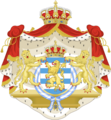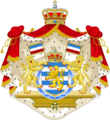Coat of arms of Eniarku
| Coat of Arms of Eniarku | |
|---|---|
 | |
| Versions | |
 Middle Coat of Arms | |
 Lesser Coat of Arms | |
| Details | |
| Armiger | Alexander, Grand Duke of Eniarku |
| Adopted | 29 May 2024 |
| Crest | Grand ducal crown of Eniarku |
| Escutcheon | Barry of seven Azure and Argent, Or a lion rampant armed and langued Gules |
| Supporters | Two golden lions |
| Orders | Most Noble Order of the Crown |
| Use | On all Acts of State; all international treaties; Eniarkian franc; cover of passports (planned). |
The national coat of arms of the Grand Duchy of Eniarku is the official coat of arms of the grand duchy and Eniarkian monarch, currently Grand Duke Alexander, in his capacity as chief of the state. Variants of the arms are sometimes used by other units of the government and, more commonly, by members of the royal family with the approval of the sovereign.
Design
The shield in the center of the arms contains only a single design, defined by the National Symbols Act of 2024 as "[b]arry of seven Azure and Argent, Or a lion rampant armed and langued Gules." The stripes represent what are considered to be the seven original realms under the Eniarkian crown throughout its history, a design originally chosen during the time of the kingdom in order to better represent the unity of the state (rather than a cluster of disparate realms and territories). The shield is surrounded by the collar of the Most Noble Order of the Crown, the highest award granted by the state and crested the grand ducal crown of Eniarku (sometimes simply referred to as the "royal crown"); the entirety of this center element is referred to as the shield of arms, and in the middle and greater arms is situated atop a large platform and supported by two golden lions, all surrounded by a red mantle with gold adornments and topped by the grand ducal crown in the in the greater arms only.
Display and use
The grand duke is the armiger of the national coats of arms, and usage of the greater coat of arms (sometimes referred to as the "royal coat of arms") is reserved for the sovereign alone and only used in rare instances by the government (such as on international treaties), not unlike the coat of arms of the Netherlands. Variations of any version of the coat of arms may be created or altered by law, and their use may be granted to individuals – typically members of the royal family or nobility – by decree of the reigning sovereign. Under the system created by the National Symbols Act of 2024, civilians are prohibited from displaying or employing any variation of the national coats of arms.
Variants
While the greater coat of arms is used exclusively by the monarch, the government typically employs the middle coat of arms on formal instruments and the "emblem" on less formal materials, which consists of the elements of the middle coat of arms without the gold platform and collar of the Most Noble Order of the Crown. The lesser coat of arms and shield of arms are rarely used, but the former does appear on the reverse of all Eniarkian franc banknotes.
-
Middle coat of arms (formal state version) -
Emblem of the Government -
Lesser coat of arms -
Shield of arms (rarely used)
Former coats of arms
The following coats of arms are those of previous incarnations of Eniarku from the time of the early republic in 2009.
-
Original coat of arms of the Republic of Eniarku -
State Eagle of the Empire of Eniarku -
Emblem of the Eniarkian Confederation -
Greater coat of arms of the Kingdom of Eniarku
Proposed coats of arms
The following coats of arms are those that were proposed but never adopted.
-
Proposed coat of arms of the Republic of Eniarku
Notes
- ↑ This arms is a slightly modified version of the state emblem used by the Ukrainian Soviet Socialist Republic from 1949 to 1991.
- ↑ This coat of arms was adopted at the time of the original union between the DPRE, Empire of New Europe, and Ohio Empire and used until its collapse in mid-2011.






![Emblem of the DPRE[a]](/images/en/images/images/thumb/c/c0/Coat_of_arms_of_Ukrainian_SSR.png/110px-Coat_of_arms_of_Ukrainian_SSR.png)
![Original coat of arms of the NAC[b]](/images/en/images/images/thumb/9/92/NAC_Coat_of_Arms_2011.png/91px-NAC_Coat_of_Arms_2011.png)



